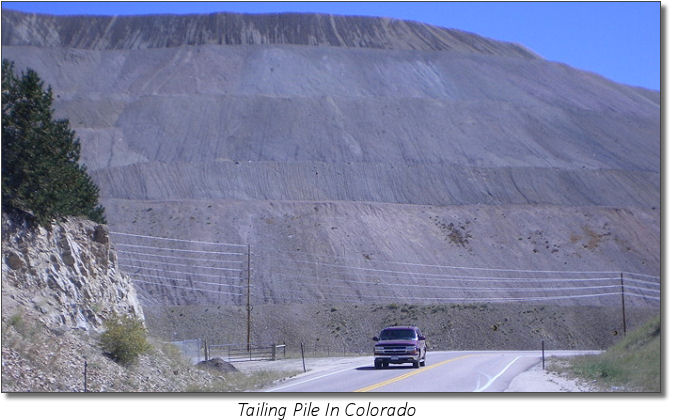Recycling The World's Mine Tailings
I was reading in an article not long ago that said there was almost two million tons of mine tailings produced everyday in Canada alone. If that is the case one has to to wonder just how many tons of tailings are produced everyday on a world wide basis? When you really start to think about this issue on a grand scale you could start by taking just one mine that runs through a thousand tons or raw material per day and then add that number to the amount of active mines around the world and you can see that there would be millions of tons per day of tailings produced. These tailing are stored and handled by various methods such as ponds, dams, dry piled or filled back to where it came.
In todays mining operations the storage and handling of tailings is a big issue. The big problem for engineers and mine planners is always the same. Where and how to dispose of tailings.
Whether it is an open pit operation or an underground operation the problem still exists and for some, these problems can become a business. From consulting companies to enviromental companies, there are always different avenues to adress the problem of tailings.
Today mining companies have to have the issue of tailings dealt with long before any kind of actual mining preceeds. However years ago the dealing with tailings was not really a concern and tailings were just dumped wherever it was handy. Most of the older mines also only high graded the ore and like any business where profits mattered, ore was run through the mill as fast as possible. In doing so however in a lot of cases, good amounts of value and of course byproducts were lost in the process and ended up in the tailing heaps. The placer mining industry at the turn of the century is a classic excample of running as much material through a wash plant in the shortest amount of time. In order to increase production, one only had to add more water but in doing so, the operation lost that much more of the finer materials to end up in the tailings.

Another factor however that comes into effect is the chemical residues such as arsenic, mercury, cyanide and many more toxins that end up in the tailings. Depending on how the tailings are stored, these toxins can leach out into the ground or in the event of the containment breaking or flooding can end up outside of the contained area.
The other issue though is what happens to all these tailing piles, ponds and containment areas after the ore is gone and mine closes up. In a lot of cases the contained areas are capped with over burden and maybe have native grasses replanted along with other vegatation. That's ok for areas that have a soil type over burden, however it is not that easy when your orginal landscape is just barren rock like much the precambrian shield which covers much of Canada. Alternative methods have to be developed to deal with this sort of reclaimation.
One company in particular called BacTech Environmental Corp. BAC is setting out to make these issues it's business. The company owns the patented BACOX bioleaching technology. This technology is used for the processing of toxic, arsenic-laden mine tailings. An added benefit of bioleaching, in addition to stabilizing arsenic and capturing heavy metals, is that it oxidizes sulphides in mine tailings, thereby eliminating a major source of acid mine drainage. The technology also recovers precious and base metals from tailings for sale to market. Bioleaching, uses a naturally-occurring bacteria, harmless to both humans and the environment, to oxidize the sulphide materials left behind after years of mining.
Bacterial oxidation technology, also known as "bioleaching" or "bio-oxidation", is a method to extract precious and base metals from difficult to treat ores, concentrates and tailings. Bioleaching uses naturally-occurring bacteria in so called reactors or holding tanks to oxidize sulphides. What this does is providing the bacteria with the optimal operating and living conditions in the holding tanks. The bioleaching method is capable of oxidizing sulphides in as little as 5-6 days, as opposed to many years if left to the elements of nature. In the end all that is really left is just the broken rock and sediments that was from the orginal ore that was crushed and processed. The rock and sediment can then be returned under ground to where it came or left piled and capped to prevent it from erosions but all the toxins along with any precious metals have been removed. Profit for a company and better for the enviroment.
Personally I can see this type of system being used more and more as time goes one. Government regulations will require such practices as part of the overall mine plan for any companies planning on putting in a mine. I am sure that as time goes on other companies will get on board as the enviromental business is big business and as long as we are mining, there is going to be tailings of some kind.
In the meantime the above article also gives you an idea of how you could maybe invest in the mining and extraction business for the future. Remember during the gold rushes it was the shop keepers who sold the picks and shovels and other supplies to the miners that made the most money with the least amount of risk.
If you enjoyed this article, please feel free to share. When seeking out mining stocks always use Due Diligence and see our Disclaimer and be sure to sign up for our free news letter located on the right hand side of this page.

